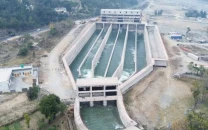Crumbling heritage: Growing rot erases city’s rich history
Provincial, civic authorities’ neglect of the city’s past is posing a question mark over its future.

It seems the old city of Rawalpindi has no care for its rich history; it is happy with its current rot in which its past and present have been abandoned to an uncertain future. The city’s rich historical heritage that the unkind passage of time has done its bit to efface has been helped in its task by an indifferent hierarchy of city fathers who have been oblivious to the value of its heritage. Time is not very far when Rawalpindi will become a city without a past.
A number of historical sites that gave the city its peculiar identity like the British colonial-era cemetery, the beautiful churches and Hindu temples are all in a state of decay and might already be lost to future generations. But this is not the end. The colonial era names of major roads have been changed to obliterate the city’s past: Dalhousie Road has been renamed as Kashmir Road, Haider Road was formerly Lawrence Road, Edwards Road has been altered to Bank Road, etcetera. The Bagh-e-Sardaran, a garden established by the Sikh community right in the heart of the city is now a congested locality. In Saddar the popular cinemas Plaza and the Odeon only exist in ruins. These were once the haunts of the city’s gentry.
Liaquat Bagh, formerly Company Bagh (after the East India Company), is a historical landmark and recent construction has shrunk it into a small public park. After independence, Liaquat Ali Khan, the nation’s first prime minister, was assassinated here in 1950. Fifty-seven years later, the first woman prime minister of the Muslim world Benazir Bhutto was assassinated in a gun and bomb attack here on December 27, 2007 in an election rally.
“There was a time when these buildings were impressive with their expensive woodwork and rare artistic inscriptions, but that time has long since passed,” Wasim Salim, an archeologist said. Similarly, the ancient sites of Bhabra Bazaar, Bagh-e-Sardaran, Dingi Khoi, Saddar, Raja Bazaar, Kalaan Bazaar, Moti Bazaar, Ratta Amral and Purana Qila are being used for residential and commercial purposes and no attempt has been made to conserve them.
Rawalpindi has an amazing pre-Partition architectural heritage. It has served as a military cantonment since the colonial era and became the Pakistan Army’s headquarters after independence, which it remains to this day. Due to this, the city is home to the Pakistan Army Museum, with displays on colonial and present day armies, armoury of historical significance and war heroes.
Rawalpindi has been inhabited for thousands of years, and it is believed that a distinct culture flourished on this plateau as far back as 1,000 BCE. The material remains found at the site prove the existence of a Buddhist establishment contemporary to Taxila, and of a Vedic civilisation.
Without the right care and attention, Rawalpindi’s rich cultural history and heritage will slip by forgotten, unknown to the generations that follow unaware of its past.
Published in The Express Tribune, November 14th, 2011.



















COMMENTS
Comments are moderated and generally will be posted if they are on-topic and not abusive.
For more information, please see our Comments FAQ